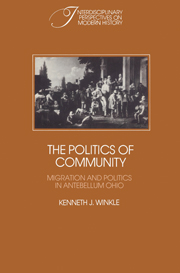Book contents
- Frontmatter
- Contents
- List of tables and figures
- Preface
- Introduction
- 1 The tide of emigration
- 2 An electorate in motion
- 3 From meeting to election: migration and suffrage
- 4 The defended community: migration and elections
- 5 “A movable column”: migration and voting
- 6 The core community: migration and leadership
- 7 Migration and local politics: an antebellum election
- Conclusion
- Notes
- Bibliography
- Index
5 - “A movable column”: migration and voting
Published online by Cambridge University Press: 06 October 2009
- Frontmatter
- Contents
- List of tables and figures
- Preface
- Introduction
- 1 The tide of emigration
- 2 An electorate in motion
- 3 From meeting to election: migration and suffrage
- 4 The defended community: migration and elections
- 5 “A movable column”: migration and voting
- 6 The core community: migration and leadership
- 7 Migration and local politics: an antebellum election
- Conclusion
- Notes
- Bibliography
- Index
Summary
A contemporary observer of migration, Ohio's commissioner of statistics, wrote during the 1850s that in any city or county “the existent people are not a uniform body whose natural increase we can calculate, but a movable column, of which one part is just coming in, and another going out.” This image of a human column moving ceaselessly through a community is very familiar to historians of nineteenth-century society. Social historians long ago faced the fact that within any ten-year period during the nineteenth century most Americans moved. They have devoted a tremendous amount of thought, energy, and argument to the precise measurement of that constant movement through nineteenth-century communities and to its implications for nineteenth-century society. Political historians, by contrast, have been slower to recognize the mobility of nineteenth-century voters and to assess its impact on political organization and behavior.
In Ohio, the westward movement, the rise of cities, innovations in transportation, and foreign immigration all combined to draw millions of migrants through the state during the antebellum decades. Most migrants traveled long distances instead of moving just locally. Further, communities in all stages of development – growth, stability, and decline – could equally experience high levels of immigration and emigration. That “tide” of long-distance movement had political implications, because during these years Ohio gradually relaxed its rules of suffrage for migrants. Both the courts and the legislature slowly granted migrants greater rights in choosing their own legal residences.
- Type
- Chapter
- Information
- The Politics of CommunityMigration and Politics in Antebellum Ohio, pp. 88 - 108Publisher: Cambridge University PressPrint publication year: 1988



